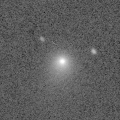
|
Now it is 9.4 mag (June 4, Juan Jose Gonzalez). It is expected to keep so bright as 6-8 mag for a long time from 2011 to 2012, and to be observable in good condition in the Northern Hemisphere. In the Southern Hemisphere, it keeps observable in good condition until October when it brightens up to 6.5 mag.
Date(TT) R.A. (2000) Decl. Delta r Elong. m1 Best Time(A, h)
June 4 23 0.96 -3 40.3 2.876 3.015 87 10.1 3:02 (300, 31)
June 11 22 58.88 -2 12.3 2.687 2.947 94 9.8 2:59 (305, 36)
|

|
It approached to the sun down to 0.88 A.U. in mid April, and it brightened up to 8.6 mag (Apr. 13, Juan Jose Gonzalez). Now it is fading, but it is still bright as 11.9 mag (June 3, Chris Wyatt). It keeps observable until it fades out, although it keeps locating somewhat low in the morning sky. It will fade out rapidly after this, and will be fainter than 18 mag in July.
Date(TT) R.A. (2000) Decl. Delta r Elong. m1 Best Time(A, h)
June 4 1 10.61 15 2.7 1.555 1.213 51 12.5 3:02 (263, 16)
June 11 1 27.69 15 41.9 1.605 1.296 53 13.3 2:59 (263, 18)
|

|
It will be 12-13 mag in June and July. However, it is not observable at all due to the bad condition in this apparition.
Date(TT) R.A. (2000) Decl. Delta r Elong. m1 Best Time(A, h)
June 4 5 55.65 24 28.4 2.361 1.415 16 13.8 20:54 (125, -6)
June 11 6 20.73 24 53.4 2.355 1.401 15 13.2 20:59 (127, -7)
|
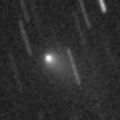
|
Now it is 13.3 mag and visible visually (May 30, Jakub Koukal). It will brighten up to 11-12 mag in autumn. In the Northern Hemisphere, it keeps observable for a long time until 2012 spring, although it becomes low temporarily in July. In the Southern Hemisphere, it is not observable until November.
Date(TT) R.A. (2000) Decl. Delta r Elong. m1 Best Time(A, h)
June 4 6 48.14 80 16.0 2.595 2.254 59 13.4 20:54 (169, 32)
June 11 7 2.46 77 16.6 2.622 2.216 55 13.3 20:59 (166, 30)
|

|
Now it is bright and visible visually at 13.1 mag (June 6, Chris Wyatt). It keeps bright as 13-14 mag for a long time after this until 2013. It is not observable in the Northern Hemisphere, but it is observable in good condition in the Southern Hemisphere.
Date(TT) R.A. (2000) Decl. Delta r Elong. m1 Best Time(A, h)
June 4 11 42.80 -81 21.2 5.179 5.671 114 13.5 20:54 ( 5,-27)
June 11 11 22.03 -80 27.1 5.182 5.657 112 13.5 20:59 ( 8,-28)
|

|
First return of a new periodic comet which brightened up to 13 mag in a major outburst in 2005. Now it is very bright as 12.2 mag and visible visually (June 4, Juan Jose Gonzalez). It will be observable in an excellent condition from summer to winter.
Date(TT) R.A. (2000) Decl. Delta r Elong. m1 Best Time(A, h)
June 4 22 46.21 -8 5.7 1.815 2.124 92 13.6 3:02 (307, 30)
June 11 22 54.38 -6 39.8 1.740 2.123 97 13.5 2:59 (310, 34)
|

|
Now it is bright as 11.0 mag and visible visually (June 6, Marco Goiato). It is getting lower in the evening sky. It will be unobservable in early July in the Northern Hemisphere, or in mid August in the Southern Hemisphere.
Date(TT) R.A. (2000) Decl. Delta r Elong. m1 Best Time(A, h)
June 4 10 44.69 1 30.4 6.189 6.257 89 13.9 20:54 ( 61, 37)
June 11 10 46.58 1 22.1 6.299 6.257 82 14.0 20:59 ( 67, 31)
|

|
It will approach to the sun down to 0.5 A.U. in September, and it is expected to brighten up to 6 mag. Now it is 13.3 mag and visible visually (June 3, Jakub Koukal). In the Southern Hemisphere, it keeps observable until early September when it becomes 7 mag. In the Northern Hemisphere, it becomes unobservable in August. But after appearing in the morning sky in October, it becomes observable in the excellent condition at midnight.
Date(TT) R.A. (2000) Decl. Delta r Elong. m1 Best Time(A, h)
June 4 10 27.70 8 11.3 1.833 1.980 82 14.3 20:54 ( 71, 38)
June 11 10 29.85 8 0.4 1.827 1.873 76 14.0 20:59 ( 76, 32)
|

|
Now it is 13.9 mag and visible visually (June 4, Jakub Koukal). It will be observable at 13-14 mag for a long time from 2011 to 2012.
Date(TT) R.A. (2000) Decl. Delta r Elong. m1 Best Time(A, h)
June 4 20 0.90 -4 44.2 4.960 5.662 129 14.1 3:02 (355, 50)
June 11 19 53.84 -4 50.9 4.849 5.640 137 14.1 2:39 ( 0, 50)
|

|
It has brightened in outburst up to 14 mag in 2006 January. Another outburst occured in late May. Now it is bright as 14.3 mag (June 4, Juan Jose Gonzalez).
Date(TT) R.A. (2000) Decl. Delta r Elong. m1 Best Time(A, h)
June 4 16 14.76 -16 28.4 7.507 8.509 170 14.6 23:24 ( 0, 39)
June 11 16 12.39 -16 22.5 7.510 8.491 163 14.7 22:54 ( 0, 39)
|

|
Big asteroid discovered in 1906. It suddenly showed the cometary activity on Dec. 11, probably due to an impact of a small object. It was very bright as 11.5 mag visually (Dec. 17, Juan Jose Gonzalez). It had a dust coma still on Jan. 9 (Joseph Brimacombe). Now it is stellar at 13.8 mag (Apr. 5, Juan Jose Gonzalez). It is getting lower in the evening sky, and will be unobservable in August.
Date(TT) R.A. (2000) Decl. Delta r Elong. m1 Best Time(A, h)
June 4 9 44.78 27 51.8 3.069 2.828 66 14.6 20:54 ( 99, 39)
June 11 9 53.24 26 47.9 3.138 2.817 62 14.6 20:59 (101, 34)
|

|
New comet. Bright as 15.2 mag (June 4, Hidetaka Sato). It will be observable at 13.5 mag in good condition in summer. In the Northern Hemisphere, it keeps observable at 14-15 mag in good condition until autumn. In the Southern Hemisphere, it will become low after August.
Date(TT) R.A. (2000) Decl. Delta r Elong. m1 Best Time(A, h)
June 4 22 42.83 -15 26.2 1.723 2.096 96 14.9 3:02 (313, 25)
June 11 22 36.90 -12 8.9 1.578 2.063 103 14.6 2:59 (318, 32)
|
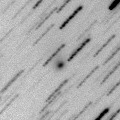
|
Now it is fading slowly, but still bright as 13.8 mag (May 30, Hidetaka Sato). It will keep 14-15 mag until mid September.
Date(TT) R.A. (2000) Decl. Delta r Elong. m1 Best Time(A, h)
June 4 23 56.19 11 38.3 3.050 2.857 69 15.0 3:02 (277, 30)
June 11 23 57.71 10 25.1 2.963 2.893 76 15.0 2:59 (282, 34)
|

|
It has returned after 27-year blank since 1984. Now it is 16.2 mag (June 5, Hidetaka Sato). It will approach to the sun down to 0.75 A.U. and brighten up to 10.5 mag in July and August. However, the condition of this apparition is bad. It locates extremely low, and only observable until mid July in the Northern Hemisphere. It locates extremely low and hard to observe in the Southern Hemisphere.
Date(TT) R.A. (2000) Decl. Delta r Elong. m1 Best Time(A, h)
June 4 1 48.57 31 6.3 1.912 1.314 40 15.8 3:02 (244, 18)
June 11 2 21.26 32 26.2 1.826 1.222 39 15.1 2:59 (242, 17)
|

|
Now it is 15.4 mag (May 14, Ken-ichi Kadota). It locates high in the Southern Hemisphere. It locates extremely low in the Northern Hemisphere, but will be getting higher gradually. It will be fading gradually, and will be fainter than 18 mag in September.
Date(TT) R.A. (2000) Decl. Delta r Elong. m1 Best Time(A, h)
June 4 23 51.45 -12 29.1 1.939 2.027 80 15.1 3:02 (298, 16)
June 11 0 0.74 -12 4.7 1.902 2.067 84 15.3 2:59 (300, 19)
|
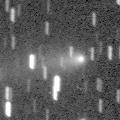
|
It reached up to 14.0 mag and became visible visually in December (Dec. 17, Juan Jose Gonzalez). Then it has been fading, and faded down to 18.3 mag on Mar. 31 (Yasukazu Ikari). However, it brightened up to 16 mag in outburst on Apr. 5. Then it keeps brightening and reached up to 14.7 mag now (May 28, Hidetaka Sato). It locates too low to observe in the Southern Hemisphere. It will be getting lower gradually after this in the Northern Hemisphere.
Date(TT) R.A. (2000) Decl. Delta r Elong. m1 Best Time(A, h)
June 4 8 46.24 37 6.5 3.271 2.786 53 15.4 20:54 (116, 32)
June 11 8 58.86 36 12.6 3.364 2.817 49 15.5 20:59 (117, 27)
|

|
Now it is 15.0 mag (May 31, Sandor Szabo). It keeps 15 mag from 2011 summer to 2012 summer. But it is not observable around the perihelion. It is observable in good condition in the Northern Hemisphere in 2011, and in the Southern Hemisphere in 2012.
Date(TT) R.A. (2000) Decl. Delta r Elong. m1 Best Time(A, h)
June 4 13 8.06 26 6.6 2.694 3.165 108 15.7 20:54 ( 43, 78)
June 11 13 8.68 25 15.3 2.722 3.116 103 15.6 20:59 ( 61, 72)
|

|
Brightening rapidly. Now it is 15.8 mag (May 29, Tzec Maun Observatory, Mayhill). It is expected to be 13 mag and will be observable in good condition in 2013. In the Northern Hemisphere, it keeps observable for a long time after this. It is not observable in the Southern Hemisphere.
Date(TT) R.A. (2000) Decl. Delta r Elong. m1 Best Time(A, h)
June 4 2 3.35 56 39.7 8.378 7.698 45 15.9 3:02 (218, 27)
June 11 2 4.96 57 15.1 8.307 7.669 48 15.9 2:59 (219, 30)
|

|
It is expected to keep 14-15 mag for a long time from 2011 summer to 2012 summer. The condition is good in the Southern Hemisphere, and it keeps observable for a long time. In the Northern Hemisphere, it is observable in the low sky in 2011 spring. But after that, it is not observable until 2012 August. However, this comet was observed only during two days in 2010 June. So the orbital elements are extremely uncertain.
Date(TT) R.A. (2000) Decl. Delta r Elong. m1 Best Time(A, h)
June 4 17 57.76 -40 28.3 2.590 3.543 156 16.1 1:11 ( 0, 15)
June 11 17 46.09 -42 19.2 2.520 3.490 159 15.9 0:32 ( 0, 13)
|

|
Now it is 16.2 mag (June 4, Ken-ichi Kadota). It will be fading very slowly after this. In the Northern Hemisphere, it keeps observable for a long time until 2012 spring when it fades down to 17-18 mag. It will not be observable in the Southern Hemisphere.
Date(TT) R.A. (2000) Decl. Delta r Elong. m1 Best Time(A, h)
June 4 22 46.20 48 14.2 5.123 4.932 73 16.0 3:02 (234, 55)
June 11 22 49.94 49 4.7 5.089 4.954 76 16.0 2:59 (232, 58)
|
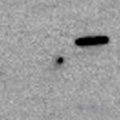
|
Now it is 16.1 mag (May 26, Hidetaka Sato). It brightens up to 12 mag in autumn. But the condition is bad. In the Northern Hemisphere, the altitude will be lower than 20 degree in June when it brightens up to 15 mag, then it will be unobservable in August. After the perihelion passage, it is only observable from December to February in the evening very low sky. In the Southern Hemisphere, it keeps observable for a long time, although it keeps locating extremely low. The component B was not detected, fainter than 20 mag (May 14, Hidetaka Sato).
Date(TT) R.A. (2000) Decl. Delta r Elong. m1 Best Time(A, h)
June 4 9 24.10 25 52.4 2.204 1.961 62 16.2 20:54 ( 99, 34)
June 11 9 34.26 24 40.4 2.213 1.897 58 16.0 20:59 (101, 29)
|

|
It reached up to 7.7 mag in 2009 summer (2009 Aug. 13, Chris Wyatt). Now it is fading. It has already faded down to 15.5 mag (May 31, Hidetaka Sato). It will never be observable again in the Northern Hemisphere. In the Southern Hemisphere, it keeps observable in good condition until 2011 autumn when it becomes fainter than 18 mag.
Date(TT) R.A. (2000) Decl. Delta r Elong. m1 Best Time(A, h)
June 4 16 51.81 -65 26.1 6.105 6.881 136 16.1 0:06 ( 0,-10)
June 11 16 37.92 -65 27.4 6.150 6.929 137 16.2 23:19 ( 0,-10)
|

|
Now it is 16.5 mag (May 30, A. Baransky). It will brighten rapidly, and will be observable at 15 mag in good condition from July to October. It locates somewhat low in the Northern Hemisphere.
Date(TT) R.A. (2000) Decl. Delta r Elong. m1 Best Time(A, h)
June 4 20 39.44 -15 10.8 1.712 2.435 124 16.5 3:02 (344, 38)
June 11 20 41.93 -15 37.8 1.631 2.420 130 16.3 2:59 (351, 39)
|

|
It became bright as 12 mag in 2010. Now it is fading. Appearing in the morning sky in the Southern Hemisphere. It will be observable also in the Northern Hemisphere in mid June.
Date(TT) R.A. (2000) Decl. Delta r Elong. m1 Best Time(A, h)
June 4 1 33.81 1 29.2 4.030 3.483 51 16.3 3:02 (271, 4)
June 11 1 40.69 2 4.7 3.972 3.504 55 16.3 2:59 (273, 8)
|

|
Now it is 17.1 mag (May 17, Hidetaka Sato). It will be observable at 17 mag in good condition from summer to autumn.
Date(TT) R.A. (2000) Decl. Delta r Elong. m1 Best Time(A, h)
June 4 22 33.74 -14 48.9 1.703 2.104 98 16.5 3:02 (315, 27)
June 11 22 43.50 -14 29.1 1.630 2.101 102 16.4 2:59 (318, 29)
|

|
Already bright as 16.5 mag (May 28, Tzec Maun Observatory). It will be observable in good condition at 12 mag in autumn and winter.
Date(TT) R.A. (2000) Decl. Delta r Elong. m1 Best Time(A, h)
June 4 23 12.51 1 10.8 2.568 2.650 83 16.7 3:02 (294, 32)
June 11 23 20.24 2 7.6 2.451 2.618 87 16.4 2:59 (297, 36)
|

|
Now it is 15.8 mag (June 2, J. F. Soulier and A. Novichonok). It will brighten up to 16 mag from summer to autumn, and will be observable in good condition.
Date(TT) R.A. (2000) Decl. Delta r Elong. m1 Best Time(A, h)
June 4 16 23.57 -1 44.2 1.322 2.297 158 16.5 23:33 ( 0, 53)
June 11 16 19.16 -1 21.8 1.312 2.271 154 16.4 23:01 ( 0, 54)
|

|
It is expected to be bright as 9 mag from 2012 to 2013. Now it is 16.3 mag (May 25, Toshiyuki Takahashi). In the Northern Hemisphere, it keeps observable in good condition for a long time until 2012 autumn when the comet brightens up to 10 mag. In the Southern Hemisphere, it is hardly observble before the perihelion passage. But it becomes observable in good condition since 2013 after the perihelion passage.
Date(TT) R.A. (2000) Decl. Delta r Elong. m1 Best Time(A, h)
June 4 11 30.78 62 37.9 6.544 6.362 75 16.6 20:54 (153, 56)
June 11 11 31.89 61 44.3 6.547 6.305 71 16.6 20:59 (149, 53)
|

|
It had been bright as 13-14 mag for a long time from 2007 to 2009. Now it is fading slowly, but it is still bright as 16.1 mag (Apr. 28, Artyom Novichonok). It is observable in good condition in the Northern Hemisphere. It locates low in the Southern Hemisphere.
Date(TT) R.A. (2000) Decl. Delta r Elong. m1 Best Time(A, h)
June 4 10 32.40 40 16.9 10.326 10.082 73 16.6 20:54 (113, 52)
June 11 10 31.89 39 53.0 10.462 10.118 67 16.7 20:59 (114, 46)
|

|
New comet. Now it is 16.2 mag (June 4, Tzec Maun Observatory). Good condition in the Southern Hemisphere. It will be getting higher also in the Northern Hemisphere. But it will fade out rapidly. It will be fainter than 18 mag in late July.
Date(TT) R.A. (2000) Decl. Delta r Elong. m1 Best Time(A, h)
June 4 16 6.39 -33 54.4 1.805 2.799 165 16.8 23:15 ( 0, 21)
June 11 15 57.70 -30 50.1 1.859 2.839 161 16.9 22:39 ( 0, 24)
|

|
Now it is 17.0 mag (May 13, J. F. Soulier). It was observed around 16 mag in 2009 and 2010. In 2011, it keeps observable at 17 mag from spring to autumn. It locates somewhat low in the Northern Hemisphere.
Date(TT) R.A. (2000) Decl. Delta r Elong. m1 Best Time(A, h)
June 4 17 21.34 -23 27.5 3.127 4.134 171 16.8 0:35 ( 0, 32)
June 11 17 16.52 -23 30.3 3.127 4.143 179 16.8 0:02 ( 0, 31)
|

|
Now it is 17.3 mag (May 23, Tzec Maun Observatory). It will brighten up to 13 mag in next winter. But the condition of this apparition is bad, and it will not be observable around the perihelion passage. It will be observable until July when it brightens up to 16 mag in the Northern Hemisphere, or until September when it brightens up to 15 mag in the Southern Hemisphere.
Date(TT) R.A. (2000) Decl. Delta r Elong. m1 Best Time(A, h)
June 4 10 36.15 17 57.3 2.261 2.331 81 16.9 20:54 ( 80, 45)
June 11 10 42.97 16 46.7 2.307 2.292 76 16.8 20:59 ( 83, 39)
|

|
Now it is 16.8 mag (June 3, P. Dupouy). In the Northern Hemisphere, it keeps observable at 17 mag in good condition until summer. It locates low in the Southern Hemisphere.
Date(TT) R.A. (2000) Decl. Delta r Elong. m1 Best Time(A, h)
June 4 15 56.66 42 35.9 3.680 4.197 114 17.3 23:05 (180, 82)
June 11 15 40.96 42 31.6 3.747 4.218 110 17.4 22:22 (180, 83)
|

|
Now it is 17.4 mag (May 28, L. Buzzi). It will approach to the sun down to 0.1 A.U. in July and August. It is not observable around the perihelion passage. But it is observable in good condition at 17.5 mag in June.
Date(TT) R.A. (2000) Decl. Delta r Elong. m1 Best Time(A, h)
June 4 15 48.16 -0 20.3 0.390 1.375 153 17.5 22:53 ( 0, 55)
June 11 14 43.23 7 23.4 0.327 1.258 132 17.5 21:20 ( 0, 63)
|

|
Now it is 16.9 mag (May 4, Hidetaka Sato). It is observable at 17 mag for a long time from 2011 to 2013. In 2011, it is observable in good condition in summer.
Date(TT) R.A. (2000) Decl. Delta r Elong. m1 Best Time(A, h)
June 4 17 48.84 3 27.2 5.263 6.162 149 17.5 1:02 ( 0, 58)
June 11 17 40.91 3 41.3 5.223 6.142 152 17.5 0:27 ( 0, 59)
|

|
Now it is 16.7 mag (May 28, Hidetaka Sato). It will be observable in good condition at 17.5 mag in 2011 spring in the Southern Hemisphere, and at 17 mag in next winter in the Northern Hemisphere.
Date(TT) R.A. (2000) Decl. Delta r Elong. m1 Best Time(A, h)
June 4 11 13.58 -11 55.3 2.071 2.471 100 17.5 20:54 ( 45, 31)
June 11 11 4.52 -9 7.5 2.190 2.433 91 17.6 20:59 ( 56, 27)
|

|
New comet. Now it is 17.6 mag (June 6, R. H. McNaught). In the Southern Hemisphere, it keeps observable at 16-17 mag for a long time from summer to winter. It is not observable in the Northern Hemisphere.
Date(TT) R.A. (2000) Decl. Delta r Elong. m1 Best Time(A, h)
June 4 22 36.32 -27 17.9 2.244 2.648 102 18.0 3:02 (322, 16)
June 11 22 39.66 -30 41.1 2.085 2.595 108 17.7 2:59 (328, 16)
|
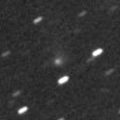
|
Now it is 17.4 mag (June 5, Catalina Sky Survey). It is fading slowly. In the Northern Hemisphere, it keeps observable in good condition until 2011 summer. It is not observable in the Southern Hemisphere.
Date(TT) R.A. (2000) Decl. Delta r Elong. m1 Best Time(A, h)
June 4 16 25.82 46 42.6 5.313 5.752 110 17.8 23:34 (180, 78)
June 11 16 17.99 45 53.1 5.355 5.780 109 17.9 22:59 (180, 79)
|

|
Now it is 17.8 mag (May 29, C. Bell). It will brighten up to 15 mag in autumn and winter. But the condition of this apparition is bad. It is not observable around the perihelion passage. It will be getting lower in the evening sky after this. In the Southern Hemisphere, it will be observable until September when it brightens up to 16 mag. In the Northern Hemisphere, it is observable only until July.
Date(TT) R.A. (2000) Decl. Delta r Elong. m1 Best Time(A, h)
June 4 11 14.66 -5 23.8 1.984 2.361 98 17.9 20:54 ( 49, 36)
June 11 11 19.25 -5 39.3 2.029 2.319 93 17.8 20:59 ( 55, 32)
|
|
![]()
 C/2010 G2 ( Hill )
C/2010 G2 ( Hill ) C/2009 F4 ( McNaught )
C/2009 F4 ( McNaught ) 213P/2009 B3 ( Van Ness )
213P/2009 B3 ( Van Ness ) 29P/Schwassmann-Wachmann 1
29P/Schwassmann-Wachmann 1 C/2010 X1 ( Elenin )
C/2010 X1 ( Elenin ) C/2006 S3 ( LONEOS )
C/2006 S3 ( LONEOS ) 174P/(60558) 2000 EC98 ( Echeclus )
174P/(60558) 2000 EC98 ( Echeclus ) (596) Scheila
(596) Scheila C/2011 L3 ( McNaught )
C/2011 L3 ( McNaught ) C/2009 Y1 ( Catalina )
C/2009 Y1 ( Catalina ) 27P/Crommelin
27P/Crommelin 9P/Tempel 1
9P/Tempel 1 240P/2010 P1 ( NEAT )
240P/2010 P1 ( NEAT ) C/2011 A3 ( Gibbs )
C/2011 A3 ( Gibbs ) C/2010 S1 ( LINEAR )
C/2010 S1 ( LINEAR ) C/2010 M1 ( Gibbs )
C/2010 M1 ( Gibbs ) C/2008 FK75 ( Lemmon-Siding Spring )
C/2008 FK75 ( Lemmon-Siding Spring ) 73P/Schwassmann-Wachmann 3
73P/Schwassmann-Wachmann 3 C/2006 W3 ( Christensen )
C/2006 W3 ( Christensen ) 48P/Johnson
48P/Johnson 65P/Gunn
65P/Gunn 130P/McNaught-Hughes
130P/McNaught-Hughes 78P/Gehrels 2
78P/Gehrels 2 115P/Maury
115P/Maury C/2011 F1 ( LINEAR )
C/2011 F1 ( LINEAR ) C/2005 L3 ( McNaught )
C/2005 L3 ( McNaught ) C/2011 L1 ( McNaught )
C/2011 L1 ( McNaught ) 74P/Smirnova-Chernykh
74P/Smirnova-Chernykh 71P/Clark
71P/Clark C/2009 UG89 ( Lemmon )
C/2009 UG89 ( Lemmon ) 2008 HE
2008 HE C/2010 R1 ( LINEAR )
C/2010 R1 ( LINEAR ) C/2011 G1 ( McNaught )
C/2011 G1 ( McNaught ) C/2011 L2 ( McNaught )
C/2011 L2 ( McNaught ) C/2007 VO53 ( Spacewatch )
C/2007 VO53 ( Spacewatch ) 37P/Forbes
37P/Forbes![]()

























